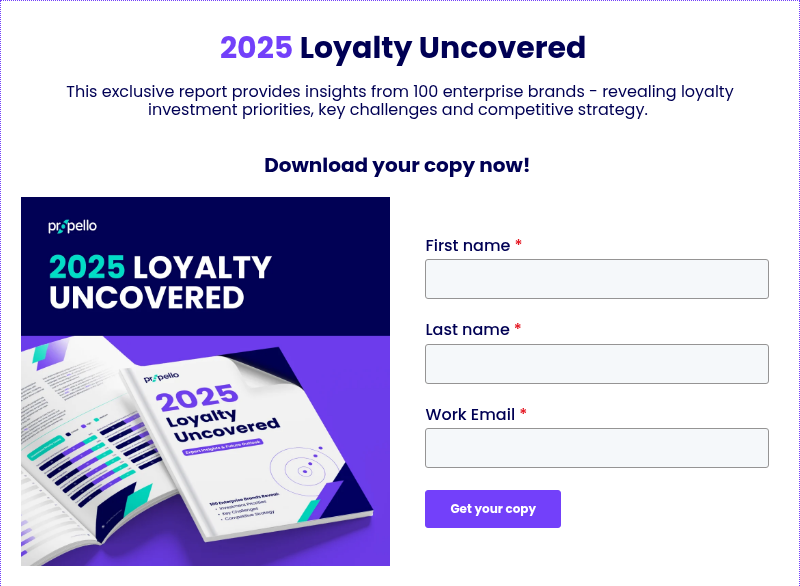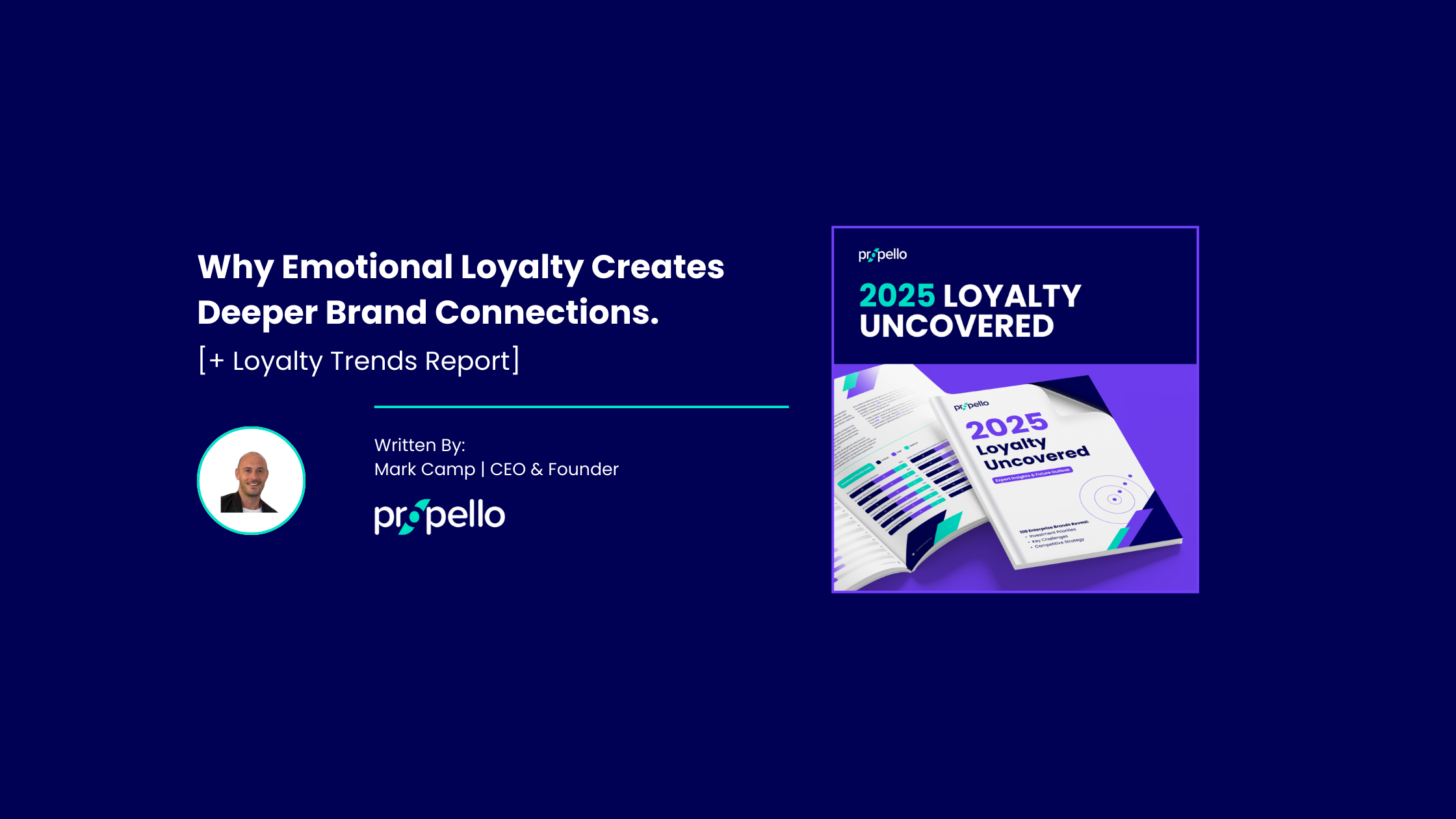Remember the last time you went out of your way to shop at your favourite store, even when there was a cheaper alternative nearby? Or when you recommended a brand to friends without being prompted or incentivised? That's emotional loyalty in action.
While transactional loyalty focuses on short term gain through points and discounts, emotional loyalty taps into something deeper. It's the difference between customers who stay because they're getting a good deal and those who stay because they genuinely connect with your brand.
Building emotional connections with customers is essential for sustainable growth. We’ll explore why emotional bonds outperforms transactional loyalty, and how you can nurture these powerful connections with your customers.
Contents:

Key Takeaways
|
Emotional loyalty creates stronger customer relationships than transactional loyalty alone, with emotionally connected customers spending 23% more on average. |
|
|
|
Trust, affinity, and attachment form the core components of emotional loyalty that drive long-term customer retention. |
|
|
Customers make purchasing decisions primarily through emotions rather than logical analysis, despite what they might believe. |
|
|
Emotionally loyal customers stay with brands for 5.1 years on average, compared to just 3.4 years for merely satisfied customers. |
|
|
Creating authentic experiences, aligning with customer values, and building community are more effective than discounts for developing lasting loyalty. |
What is Emotional Loyalty?
Emotional loyalty is the heartfelt connection customers feel toward a brand beyond rational factors like price or convenience. It's what makes people choose your brand even when competitors offer better deals.
This type of loyalty stems from how customers feel when they interact with your brand. Do they feel understood? Valued? Part of a community? These emotional responses create bonds that transactional loyalty simply can't match.
Brands that successfully build emotional loyalty don't just gain repeat customers—they gain enthusiastic advocates who identify with the brand's values and feel personally invested in its success.
The Science Behind Emotional Loyalty
Your brain processes emotional connections differently than logical decisions. Research in neuroscience shows that emotional responses are processed faster and leave stronger memory imprints than rational thoughts.
When customers form emotional bonds with brands, the brain's reward centres activate in ways similar to personal relationships. This neurological response explains why emotionally connected customers are less price-sensitive and more likely to remain loyal during tough times.
The dopamine release that occurs when we have positive brand experiences keeps us coming back—not because we've calculated the best value, but because we emotionally associate the brand with positive feelings.
Emotional vs. Rational Decision-Making
We like to think we make purely rational purchasing decisions, but research suggests otherwise. Studies consistently show that emotions drive consumer behaviour more powerfully than logical analysis.
Consider how you choose restaurants. While you might check prices and reviews, your final decision often comes down to how you feel about the place—memories of previous visits, the atmosphere, or how staff made you feel welcome.
This emotional component explains why customers often can't articulate exactly why they prefer one brand over another with similar offerings. The decision happens at an emotional level that rational decision-making rarely addresses.
Transactional Loyalty vs Emotional Loyalty
Let’s differentiate emotional and rational loyalty even further by understanding the differences between these two concepts.
Key Differences Between Emotional and Transactional Brand Loyalty
Transactional loyalty is straightforward: customers return because they get concrete benefits like points, discounts, or free items. It's a calculated relationship based on "what's in it for me?"
Emotional loyalty, by contrast, is built on identification with brand values, personal connections with staff, memorable experiences, and the sense of belonging to something meaningful. Customers stay because they want to, not because they've calculated a better deal.
The clearest distinction appears when competitors offer better incentives. Transactionally loyal customers will jump ship for better deals, while emotionally loyal customers often remain steadfast despite attractive alternatives.
Why Emotional Loyalty Matters More
Emotionally loyal customers spend more, stay longer, and become brand advocates.
Research by Gallup found that customers with strong emotional connections to brands deliver a 23% premium in terms of share of wallet, profitability, and relationship growth.
These customers are also less expensive to maintain. While transactional loyalty requires ongoing investment in discounts, emotional loyalty creates self-sustaining relationships that don't always need financial incentives to thrive.
Perhaps most valuably, emotionally loyal customers provide authentic word-of-mouth marketing that outperforms paid advertising. Their recommendations carry the weight of genuine enthusiasm rather than transaction-driven referral incentives.
The Synergy Between Transactional and Emotional Loyalty
All this isn't to say you should abandon your points programme. The most effective loyalty strategies combine both approaches, using transactional benefits as the entry point to deeper emotional connections.
Your points programme might get customers in the door, but personalised experiences, exceptional service, and alignment with customer values will keep them coming back long after competitors offer better deals.
Smart brands use data from their loyalty programmes to deliver more meaningful, personalised experiences that strengthen emotional bonds. The transaction becomes a means to understand customers better, not just to incentivise them temporarily.
Components of Emotional Loyalty
Here are the building blocks of emotional loyalty and how they drive customer behaviour.
AffinityAffinity is the natural attraction customers feel toward your brand. It grows when your brand values align with customer values and when your communications resonate on a personal level. |
AttachmentAttachment forms when customers integrate your brand into their routines and identity. Apple users don't just own products—they become "Apple people," with the brand becoming part of how they see themselves. |
TrustTrust is perhaps the most fundamental component of emotional loyalty. It develops when brands consistently deliver on promises, demonstrate transparency, and show genuine care for customer interests. |
Benefits of Emotional Loyalty
Now let’s see how those components translate into tangible benefits for your brand.
Increased Customer Lifetime ValueEmotionally connected customers are typically 52% more valuable than those satisfied but not emotionally engaged. They also buy more frequently and explore more of your product lines. |
Higher Retention RatesCustomer acquisition costs continue to rise across industries. Emotional loyalty provides a shield against these costs by dramatically improving retention rates. Research by Motista found that emotionally connected customers stay with brands for an average of 5.1 years, compared to 3.4 years for customers satisfied but not emotionally connected. This retention advantage becomes particularly valuable during economic downturns when customers reassess spending and cut back on non-essential purchases. |
Positive Word-of-Mouth and Brand AdvocacyEmotionally loyal customers don't just silently continue buying—they actively champion your brand to others. This authentic advocacy is marketing gold in an age where consumers increasingly distrust traditional advertising. |
Competitive AdvantageIn markets where products and services are increasingly similar, emotional loyalty provides a differentiation advantage that's difficult for competitors to replicate. |
Resilience to Market ChangesPerhaps the most valuable benefit in today's volatile market is the stability that emotional loyalty provides during disruptions. |
How to Build Emotional Loyalty
Now that you know the benefits, the next logical question is: how can you create lasting emotional connections with your customers?
Personalised ExperiencesPeople don't want to feel like just another transaction. Personalisation shows customers you recognise them as individuals with unique preferences and needs. |
Authenticity and Brand ValuesToday's consumers can spot insincerity from miles away. Building emotional loyalty requires genuine commitment to values that resonate with your target audience. |
Exceptional Customer ServiceOutstanding service remains one of the most powerful ways to build emotional connections. When customers feel truly cared for—especially during difficult situations—loyalty deepens dramatically. |
Community BuildingHumans naturally seek belonging. Brands that create genuine communities around shared interests or values tap into this fundamental need.
Fitness brands like Peloton have mastered this approach, creating communities where members encourage each other while building stronger connections to the brand itself. |
Surprise and Delight StrategiesUnexpected positive experiences create disproportionately strong emotional responses. Strategic surprise moments can transform ordinary customers into passionate advocates. |
Best Practices for Nurturing Emotional Loyalty
Are you prepared to put theory into practice and get started? Let us examine three essential actions to take when putting the emotional loyalty tactics covered in the previous section into practice.
Create an Emotional Loyalty StrategyStart with clarity about what you want to achieve. An effective emotional loyalty strategy begins with specific goals:
Next, map your customer journey to identify emotional touchpoints—moments where customers are most receptive to forming emotional connections. These often include first purchases, problem resolution, milestone achievements, and life transitions. |
Leverage Technology and DataTechnology helps you scale personal connections that once required face-to-face interactions. The right tools can transform cold data into warm relationships. Consider how these technologies support emotional connections:
The key is using technology to enhance human connections, not replace them. The best systems empower your team to create more meaningful interactions rather than automating humanity out of the relationship. |
Train Your TeamYour employees are the face of your emotional loyalty strategy. Their ability to create authentic connections determines whether customers feel valued or processed.
The most effective training uses actual customer scenarios rather than abstract principles. Role-playing tough situations helps staff develop the confidence to handle emotional moments effectively. |
How to Measure Emotional Loyalty
You've put effort into building emotional connections. But how do you know if it's working? Let's look at practical ways to measure what seems unmeasurable.
Net Promoter Score (NPS)NPS gives you a clear window into customer advocacy by asking one powerful question: "How likely are you to recommend our brand to friends or colleagues?" To get meaningful insights from NPS:
NPS works best as a conversation starter, not the final word on loyalty. The follow-up questions often reveal the emotional factors driving the scores. |
Customer Satisfaction MetricsWhile satisfaction isn't the same as emotional loyalty, tracking satisfaction at key moments helps identify emotional connection points. |
Sentiment AnalysisWhat customers say about you—and how they say it—reveals their emotional connection. Modern sentiment analysis tools help you track emotional signals across:
Look beyond positive/negative classifications to identify emotional themes. Are customers using language that suggests belonging ("my store," "our community")? Do they express emotions like pride, trust, or excitement when discussing your brand? |
Customer Lifetime ValueEmotional loyalty ultimately shows up in behaviour—and in your bottom line. Tracking Customer Lifetime Value (CLV) helps quantify the impact of your emotional loyalty initiatives.
When you see CLV increases that outpace promotional spending, that's often a sign that emotional connections—not just transactions—are driving behaviour. |
Engagement MetricsDigital engagement often serves as a proxy for emotional connection. Look beyond basic metrics like page views to indicators of deeper engagement:
A customer who reads your blog posts, participates in your online community, and shares your content likely feels an emotional connection that transcends transactions. |
Successful Emotional Loyalty Programme Examples
Let's explore how different industries are putting emotional loyalty into practice with remarkable results.
-
Sephora's Beauty Insider goes beyond points and discounts by creating a genuine beauty community. Their tiered programme offers personalised recommendations and exclusive events that make customers feel like insiders rather than just shoppers. The magic lies in how they recognise individual beauty journeys, not just transaction histories.
-
Levi's "Refer a Friend" campaign tapped into deeper values by planting trees for customer referrals. This simple initiative transformed a standard referral programme into a meaningful environmental partnership. Customers weren't just buying jeans—they were supporting sustainability alongside a brand that shares their values.
-
Airbnb builds emotional loyalty without a traditional points programme at all. By fostering authentic connections between hosts and guests and celebrating real travel stories, they've created a global community bound by shared experiences. Their approach demonstrates how emotional loyalty can emerge organically when you facilitate meaningful human connections.
-
Samsung rewards engagement as much as purchases, recognising that loyal advocates provide value beyond their spending. By acknowledging customers who write reviews or help others in forums, they transform passive buyers into active community members who feel personally invested in the brand's success.
-
Percival's "The Closed Circle" takes exclusivity in a refreshing direction. This British menswear brand invites loyal customers into private WhatsApp and Instagram groups where they participate in product discussions and receive behind-the-scenes content. The approach creates genuine two-way dialogue rather than one-way marketing.
What these diverse examples share is authenticity. Each brand has found a unique approach to emotional loyalty that aligns with their values and resonates with their specific customer base.
The Future of Emotional Loyalty
As markets evolve and technology advances, emotional loyalty continues to change. Understanding emerging trends helps in staying ahead of changing expectations and retaining customers.
Emerging TrendsSeveral shifts are reshaping how brands build emotional connections:
According to a 2023 survey, 63% of consumers support or purchase from brands because they share their values. The proportion of respondents in the UK who make purchases based on shared values also rose to about 60%, between 2013 and 2021.
80% of consumers are comfortable with personalised experiences and expect companies to offer them.
|
The Role of AI and PersonalisationArtificial intelligence is transforming emotional loyalty from art to science without losing the human touch.
The brands succeeding with AI focus on augmenting human connections rather than replacing them. Technology works behind the scenes to make human touchpoints more meaningful and relevant. |
Adapting to Changing Consumer ExpectationsToday's consumers bring new expectations to every brand relationship. Meeting these expectations requires continuous evolution. According to an Accenture survey, 62% of customers worldwide want brands to take a stance on issues that are important to them on a social, cultural, environmental, and political level. Speed of response continues to accelerate. Customers expect near-immediate acknowledgement of their needs, even if full resolution takes time. The feeling of being heard quickly creates emotional goodwill that buys patience for more complex solutions. |
Back to contents
Gain a Competitive Advantage with Emotional Bonds
Points programmes and discounts will always have their place in customer retention strategies. But the brands that thrive long-term are those that recognise these programmes as just the beginning—not the end goal—of customer relationships.
Building emotional loyalty requires genuine commitment to understanding what matters to your customers beyond transactions. It means creating experiences that resonate on a personal level and consistently demonstrating values that align with theirs.
The effort is substantial, but so are the rewards. Customers who stay longer, spend more, refer potential customers, and stand by you through challenges. In today's competitive marketplace, that's a return on investment worth pursuing.
See how top brands are developing emotional connections with their customers in our Loyalty Uncovered Report 2025

FAQs
What is emotional loyalty, and how does it differ from transactional loyalty?
Emotional loyalty is a deep psychological connection customers feel towards a brand, while transactional loyalty is purely rational. What makes emotional loyalty important is that it creates important relationships built on shared values and meaningful interactions rather than mere financial exchanges.
Why is emotional loyalty more beneficial for brands than a points-based customer loyalty programme?
Unlike points programmes that offer temporary benefits, emotional loyalty creates a genuine brand connection that withstands competitors' offers. Companies that enhance customer relationships through emotional bonds create sustainable revenue streams and stronger market positions.
How can brands develop emotional loyalty among their customers?
Brands can build customer loyalty by consistently delivering value beyond transactions, personalising interactions, and demonstrating authentic care. Actively seeking feedback and creating a sense of community around shared values drives customer engagement and meaningful emotional connections.
What role do customer experiences play in building emotional loyalty?
Customer experiences directly impact emotional attachment when they consistently exceed expectations. Memorable, positive customer touchpoints across all channels build trust through reliability and exceptional service, transforming satisfied customers into passionate brand advocates.
Can emotional loyalty be measured, and if so, how?
Yes, emotional loyalty can be measured through Net Promoter Scores, sentiment analysis, customer lifetime value, and engagement metrics. Mobile apps provide valuable data on user behaviour, while qualitative research helps companies understand emotional drivers behind purchasing decisions.
What are some examples of brands that have successfully built emotional loyalty?
Apple, LEGO, and Patagonia excel at building emotional loyalty. These brands offer customer experiences aligned with core values—innovation, creativity, and sustainability respectively—creating communities of passionate users who feel personally connected to these brands' missions.
How does emotional loyalty impact customer retention and lifetime value?
Emotionally loyal customers display higher retention rates and spend significantly more over time. When positive customers feel genuine connection, they're less price-sensitive and more forgiving of occasional mistakes, dramatically increasing their overall lifetime value.
Are there specific industries where emotional loyalty is more critical?
Service-oriented industries like hospitality, healthcare, and luxury retail particularly benefit from emotional loyalty. Sectors where consumers build trust through repeated personal interactions see stronger competitive advantages when emotional connections become part of their core strategy.
What challenges do businesses face when shifting from points-based to emotion-based loyalty strategies?
Transitioning from points-based to emotion-driven loyalty requires cultural transformation, not just programme redesign. Organisations struggle to align marketing campaigns with authentic values, retrain staff, properly measure customer loyalty, and maintain consistency across touchpoints.
How does emotional loyalty influence word-of-mouth marketing and brand advocacy?
Emotionally connected customers become powerful brand ambassadors, actively promoting companies through authentic word-of-mouth recommendations. Their genuine enthusiasm helps attract new customers more effectively than traditional advertising, particularly amongst sceptical consumers seeking trusted opinions.
Author Bio, Written By:
Mark Camp | CEO & Founder at PropelloCloud.com | LinkedIn
Mark is the Founder and CEO of Propello Cloud, an innovative SaaS platform for loyalty and customer engagement. With over 20 years of marketing experience, he is passionate about helping brands boost retention and acquisition with scalable loyalty solutions.
Mark is an expert in loyalty and engagement strategy, having worked with major enterprise clients across industries to drive growth through rewards programmes. He leads Propello Cloud's mission to deliver versatile platforms that help organisations attract, engage and retain customers.



.png)